Related Research Articles

Starfish or sea stars are star-shaped echinoderms belonging to the class Asteroidea. Common usage frequently finds these names being also applied to ophiuroids, which are correctly referred to as brittle stars or basket stars. Starfish are also known as Asteroids due to being in the class Asteroidea. About 1,500 species of starfish occur on the seabed in all the world's oceans, from the tropics to frigid polar waters. They are found from the intertidal zone down to abyssal depths, 6,000 m (20,000 ft) below the surface.
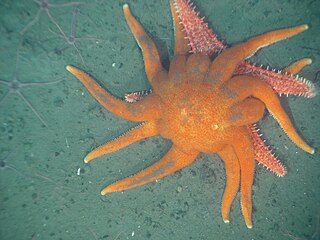
The Valvatida are an order of starfish in the class Asteroidea, which contains 695 species in 172 genera in 17 families.

The Echinasteridae are a family of starfish in the monotypic order Spinulosida. The family includes eight genera and about 133 species found on the seabed in various habitats around the world.

The Asterinidae are a large family of sea stars in the order Valvatida.

The Asteriidae are a diverse family of Asteroidea in the order Forcipulatida. It is one of three families in the order Forcipulatida.
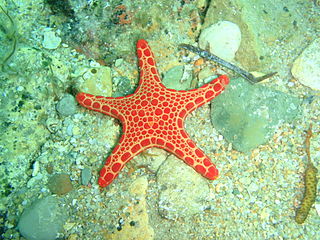
Goniasteridae constitute the largest family of sea stars, included in the order Valvatida. They are mostly deep-dwelling species, but the family also include several colorful shallow tropical species.
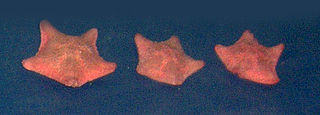
Asterina is a genus of asteroideans in the family Asterinidae.

The Forcipulatida are an order of sea stars, containing three families and 49 genera.
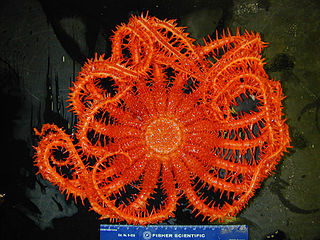
The Brisingids are deep-sea-dwelling starfish in the order Brisingida.

The Asterozoa are a subphylum in the phylum Echinodermata. Characteristics include a star-shaped body and radially divergent axes of symmetry. The subphylum includes the two classes Asteroidea, the starfish, and Ophiuroidea, the brittle stars and basket stars, and the extinct order Somasteroidea.
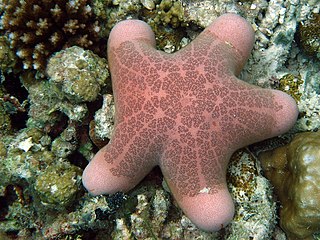
The Oreasteridae are a family of sea stars in the class Asteroidea.
Acheronaster tumidus is a species of sea stars in the family Oreasteridae. It is in the monotypic genus Acheronaster.

Halityle regularis, sometimes known as the Mosaic Cushion Star, is a species of sea stars in the family Oreasteridae. It is the sole species in the genus Halityle. It lives in depths of 16 – 90 meters.
Pseudanthenea grayi is a species of sea stars in the family Orestieridae. It is the sole species in the genus Pseudanthenea.
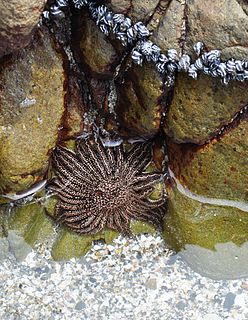
The Heliasteridae are a family of Asteroidea in the order Forcipulatida. It includes two genera: Heliaster from the East Pacific, and Labidiaster from southernmost South America, Antarctica and subantarctic oceans.

The Zoroasteridae are one of three families of Asteroidea in the order Forcipulatida. It contains seven living genera and one extinct genus.

Apollonaster is a genus of abyssal sea stars in the family Goniasteridae. They can be identified by their bare abactinal plate surfaces and multiple accessory granule rows on their abactinal plates. To date, Apollonaster has been found in the tropical Atlantic region and Hawaiian Islands region oceans, with no other locations or species being known as of 2015.

Heliaster is a genus of Asteroidea in the family Heliasteridae.
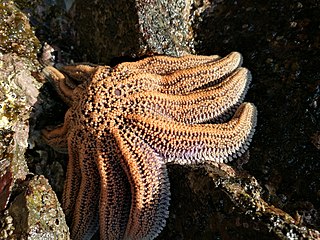
The Stichasteridae are a small family of Asteroidea in the order Forcipulatida. Genera were formerly unassigned, or in the family Asteriidae.
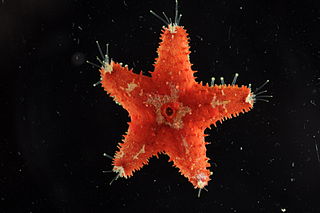
Euretaster insignis, commonly known as the striking sea star, is a species of starfish in the family Pterasteridae found in the central west Pacific Ocean. It is one of only three species in the order Velatida to be found in shallow water in the tropics. The young are brooded in a cavity underneath a "supradorsal" membrane.
References
- 1 2 C.L. Mah (2010). "Asteroidea taxon details for Bothriaster Döderlein, 1916". World Asteroidea Database. Retrieved June 29, 2011.CS1 maint: discouraged parameter (link)